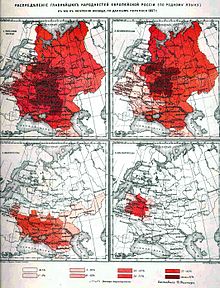

Triune Russian (Ruthenian) people (Russian триединый русский народ, Ukrainian триєдиний руський народ, Belarusian трыядзіны рускі народ) was the idea of the Russian nation in the broad sense that consists of three branches: Great Russians, Little Russians and White Russians. It was the state-constitutive conception in the Russian Empire and scientific standard in Russia and most other countries before (and some time after) the Russian revolution[1].
Translation specifics edit
In the Russian language, the word русский (russkiy) is a single adjective to the word Русь which means the historical region Rus. In the modern era, the two medieval forms of this region's name in Latin, Russia and Ruthenia, after a period of interchangeability, became the basis for the terminological distinction between Eastern Slavs in the English language. The first term primarily designated lands of Eastern Slavs who were subjects of the Tsar (modern Russians), the second described lands of Eastern Slavic subjects of the Polish-Lithuanian Commonwealth, the ancestors of modern Ukrainians and Belarusians. Also, the term Ruthenian is sometimes used to describe issues concerning the people of medieval Kievan Rus' in order to distinguish them from modern Russians. The Russian language traditionally doesn't have this distinction. For this reason, the Russian expression триединый русский народ which refers to Rus' and Russia at once, can be translated both ways and is dependent on the historical or the political focus.
History edit
Russian Tsardom and Russian Empire edit
The upcoming of a new state ideology was connected with the integration of the Left-bank Ukraine into the Russian state in the second half of the 17th century[2] According to Ukrainian philosopher Sinyakov, the unification idea of Ukraine and Russia was not imposed by the Moscow government but was originally Ukrainian. Different initiatives began already at the end of 16th century and the idea strengthened in the course the 17th century[2]. The influential Kievan Synopsis, written by the archimandrite of the Kiev Caves monastery Innocent Gizel, contained the description of the ancient unity of the "Russian peoples". Modern researchers see this work as the beginning of the historical conception of a common Old Russian ethnicity of Kievan Rus.[3] In the following, Synopsys played the role of some kind of a spiritual constitution of the reunified lands.[2]
The first author and ideologist of the conception of a triune Russian people was the Kiev-born achbishop of the Russian Orthodox Church and professor of the Kiev-Mohyla Academy Theophan Prokopovich[2]. He taught that the Russian people is triune just like the title Tsar of Great, Little and White Russia.[2]
According to Russian historian Andrei Marchukov, the triune Russian people constituted the ethnic and cultural center of the Russian Empire. He believes that the multinational Russian Empire can be imagined a spheric circles that surrounded the triune Eastern Slavic state-constitutive nucleus.[4] The prominent historian Vasily Klyuchevsky supposed that the division of the Russian people occured in the era of feudal split when it underwent a division in two parts while the Western part later split into Little Russians and Belarusians[5]. Thus, the Old Russian (Old Ruthenian) people gave birth to three branches of the All-Russian people of his time[6] The well-known historian Nikolay Kostomarov also acknowledged the existence of an All-Russian people.[7]
Soviet era edit
Present times edit
References edit
- ^ Реєнт О. П. Українсько-білоруські взаємини у XIX - на початку XX ст.: процес становлення (укр.) // Головний редактор: В. А. Смолій Український історичний журнал : науковий журнал. — Київ: Інститут історії НАНУ, 2008. — В. 1 (478). — С. 161-169. — ISSN 0130-5247.
- ^ a b c d e Синяков С. В. Украинская история как пространство современного творчества (рус.) // Вісник Національного технічного університету України “Київський політехнічний інститут”. Філософія. Психологія. Педагогіка : науковий журнал. — Київ, 2011. — В. 2. — С. 151-158. — ISSN 0201-744X.
- ^ Юсова Н. Н. Давньоруської народності концепція // Енциклопедія історії України. У 5 т. / Редкол В. А. Смолій та ін. — Інститут історії України НАН України. — Київ: Наукова думка, 2003. — Т. 2. Г-Д. — С. 275-276. — 528 с. — 5000 экз. — ISBN 966-00-0405-2
- ^ Марчуков А. В. Украинское национальное движение: УССР, 1920-1930-е годы : цели, методы, результаты. — Москва: Наука, 2006. — С. 28. — 528 с.
- ^ Ключевский В. О. Сочинения: В 9 т. М., 1987. Т. І. Курс русской ис-тории. Ч. І. С. 294, 295-296, 298
- ^ Юсова Н. Н. Идейная и терминологическая генеалогия понятия «древнерусская народность» (рус.) // Rossica antiqua : научно-теоретический журнал. — Санкт-Петербург: Исторический факультет Санкт-Петербургского государственного университета, 2010. — В. 2. — С. 1-53.
- ^ Мысли о федеративном начале в Древней Руси // Собраніе сочиненій: Историческіе монографіи и изследованія. 8 кн., 21 т. — СПб, 1903. — Т. 1, Кн. 1. — С. 24.
